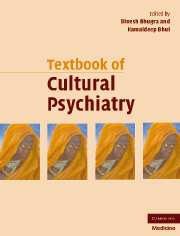Book contents
- Frontmatter
- Contents
- Contributors
- Foreword
- Preface
- Part I Theoretical background
- Part II Culture and mental health
- Part III Culture and mental disorders
- Part IV Theoretical aspects of management
- Part V Management with special groups
- 35 Intellectual disabilities across cultures
- 36 Child psychiatry across cultures
- 37 Management of sexual dysfunction across cultures
- 38 Refugees and mental health
- 39 Working with elderly persons across cultures
- 40 Working in liaison psychiatry
- Part VI Cultural research and training
- Cultural psychiatry: the past and the future
- Index
- References
40 - Working in liaison psychiatry
from Part V - Management with special groups
Published online by Cambridge University Press: 11 August 2009
- Frontmatter
- Contents
- Contributors
- Foreword
- Preface
- Part I Theoretical background
- Part II Culture and mental health
- Part III Culture and mental disorders
- Part IV Theoretical aspects of management
- Part V Management with special groups
- 35 Intellectual disabilities across cultures
- 36 Child psychiatry across cultures
- 37 Management of sexual dysfunction across cultures
- 38 Refugees and mental health
- 39 Working with elderly persons across cultures
- 40 Working in liaison psychiatry
- Part VI Cultural research and training
- Cultural psychiatry: the past and the future
- Index
- References
Summary
EDITORS' INTRODUCTION
Liaison psychiatry or consultation–liaison psychiatry (also known as general hospital psychiatry) deals with psychiatric aspects of physically ill individuals. Occurring both in out-patient and in-patient settings, this specialty within psychiatry has continued to evolve over the last 50 years or so.
In this chapter, Chaturvedi and Thoduguli provide an outline of the history of development of psychiatry and various models which are used. Providing a cultural context, they point out that the patient's perception of their physical disease and means of coping with it are subject to cultural influences in a big way. The treating team's relationship with the patient and carers is likely to be determined by cultural factors. For example, in cultures where clinicians are given tremendous status, the therapeutic relationship may have stronger elements of dependence. In addition, religious and spiritual factors may play a bigger role. Using examples from medical specialties such as cardiology, oncology, nephrology and gynaecology, these authors discuss specific difficulties related to somatization.
Introduction
Consultation–liaison psychiatry is a clinical discipline which deals with biological, psychological and social factors in the causation and management of any disorder, particularly the psychiatric manifestations. The field has its origins in the early nineteenth century, when medicine sought to explain all illnesses as the result of a specific biological cause. Parallel to this was the trend in psychiatry to view the major psychiatric disorders as resulting from biological disturbances.
- Type
- Chapter
- Information
- Textbook of Cultural Psychiatry , pp. 526 - 534Publisher: Cambridge University PressPrint publication year: 2007



